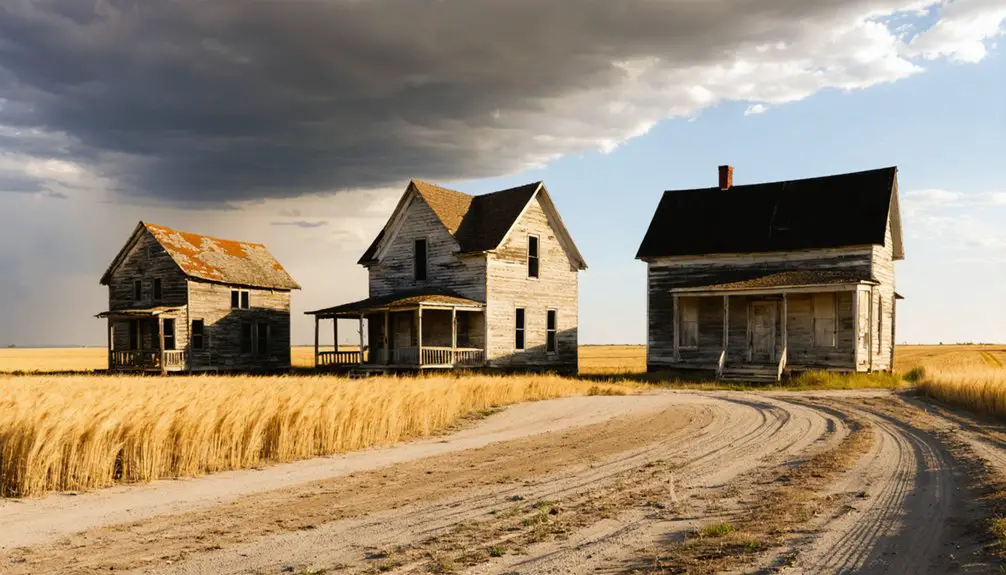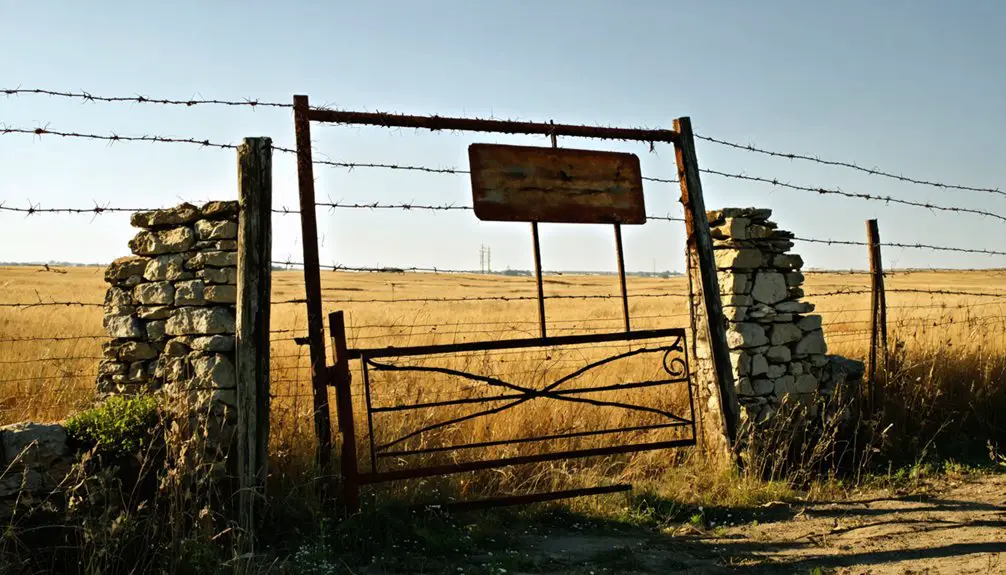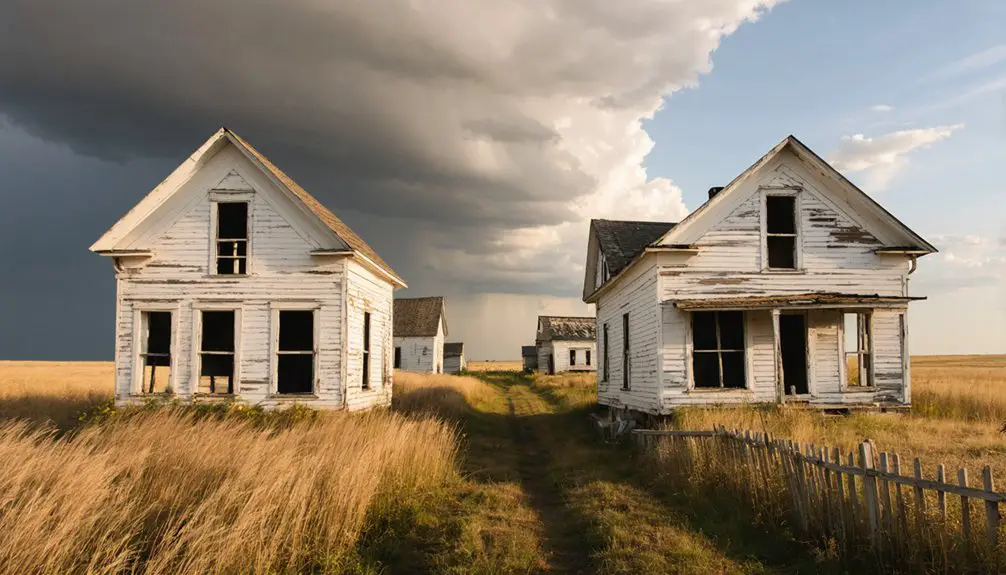You’ll discover Four Houses as a fascinating Kansas ghost town near the Missouri and Kansas Rivers’ confluence, where up to 600 residents once lived during its 19th-century peak. The town thrived on coal mining, farming, and river transport before declining due to changing transportation routes and economic shifts. Today, you can explore the remaining brick high school, deteriorating homes, and grain elevators amid heavily wooded terrain—each structure telling a story of frontier life and adaptation.
Key Takeaways
- Four Houses was a 19th-century Kansas settlement near the Missouri and Kansas Rivers that grew to 600 residents before becoming abandoned.
- The town relied heavily on coal mining and farming, with its decline linked to changes in transportation routes and agricultural mechanization.
- Key structures included four churches, a brick high school, and various businesses, though most buildings are now in ruins.
- The site currently features abandoned buildings, stone foundations, and a Portland Cement Company plant amid heavily wooded terrain near Elk City Lake.
- Civil War tensions and raids between 1864-1869 initially stunted the town’s growth before post-war settlement opportunities emerged through the Homestead Act.
The Rise and Fall of a Frontier Settlement
While many frontier settlements in Kansas thrived during the mid-to-late 19th century, Four Houses emerged as a modest outpost in Wyandotte County near the confluence of the Missouri and Kansas Rivers.
You’ll find its story reflects the frontier challenges faced by countless settlements of that era. The town’s strategic location offered early settlers access to river transport and fertile farmland, positioning itself as a potential trade center. Like the mining town of Empire City, Four Houses was one of many towns that experienced a population boom before its decline.
Yet despite these natural advantages, Four Houses struggled to overcome significant community dynamics shaped by Civil War tensions and limited infrastructure. General Order 11 drastically impacted settlement patterns in the region.
Despite promising beginnings, internal conflicts and poor development hobbled Four Houses’ growth in an era of expanding frontier settlements.
Without securing vital railroad connections, the settlement couldn’t compete with better-connected towns like Leavenworth and Lansing. This isolation, combined with declining agricultural prospects and the exodus of residents seeking better opportunities, ultimately led to the town’s abandonment.
Life in Four Houses During Its Peak Years
During its peak years, Four Houses bustled with a vibrant community of up to 600 residents, including miners, shopkeepers, clergy, and professionals who shaped the town’s dynamic social fabric.
You’d find community gatherings centered around the town’s four churches and local schools, where families came together to strengthen their social bonds.
While daytime activities revolved around coal mining and farming, nightlife thrived in the saloons and brothels that dotted the landscape.
Without formal law enforcement, you’d need to watch your step as social dynamics could quickly shift from friendly to volatile.
The mix of permanent families and transient workers created a diverse atmosphere where you could find everything from religious services to rowdy entertainment, typical of America’s frontier spirit.
The town’s prosperity relied heavily on its coal mining boom, making it vulnerable to economic instability when the industry declined.
Like many Kansas towns that lost their primary industries, Four Houses gradually declined as coal mining operations ceased.
Architectural Legacy and Physical Remains
If you visit Four Houses today, you’ll find a small collection of deteriorating structures that showcase the pragmatic building approaches common to 19th-century Kansas frontier settlements.
The remaining buildings feature simple frame construction with hip roofs and modest porches, built using locally available materials rather than the ornate architectural styles popular in the eastern United States. Early settlers focused on comfort and practicality over aesthetics due to the challenging frontier conditions. Like many other Kansas settlements, the town’s fate was sealed when railroad development never materialized.
The ghost town’s physical legacy primarily consists of partially deteriorated homes, cemetery grounds, and building foundations, though modern agricultural development has obscured some of the original settlement’s footprint.
Standing Structures Today
Despite years of abandonment, Four Houses, Kansas retains several significant architectural remnants that tell the story of its past.
You’ll find a brick high school building, though deteriorating, standing as a symbol of the town’s educational heritage. Much like new fire department buildings in other ghost towns, some structures have been updated while original buildings decay. The landscape is dotted with abandoned homes in various states of decay, some maintaining their basic structural integrity while others succumb to nature’s elements. Like many communities in the Great Plains, the town suffered economic decline during devastating agricultural downturns.
- The brick schoolhouse remains the most prominent landmark, its weathered walls echoing with memories of bustling classrooms.
- Scattered residential structures reveal the original town layout, with some still occasionally occupied.
- Agricultural remnants like grain elevators stand as silent sentinels, marking the town’s farming roots.
The commercial district contains several surviving business buildings, while former public service structures, including the fire station, continue their slow descent into ruins.
Construction Methods and Materials
The architectural legacy of Four Houses reveals a rich tapestry of pioneer construction methods and locally-sourced materials.
Similar to the Honeywell House Hotel of 1880, builders prioritized sturdy wooden construction methods. You’ll find evidence of foundation stability through limestone bases, which have endured despite decades of prairie winds and weather. The remnants showcase the era’s common framing techniques, particularly balloon framing with dimensional lumber that enabled quick construction during the town’s development. Similar to other communities that were built around railroads, Four Houses exemplified typical construction patterns of Kansas frontier settlements.
When you explore the site today, you’ll notice surviving stone foundations and chimney bases that tell the story of pioneer ingenuity.
These structural elements have outlasted their wooden counterparts, which have largely succumbed to natural decay. Metal artifacts, including roofing fragments and hardware, provide tangible proof of how settlers adapted available materials to create lasting structures in this remote Kansas location.
Documented Building Locations
Building on these structural foundations, documented locations of Four Houses‘ remaining structures paint a picture of the town’s original layout.
While specific documentation about Four Houses is limited, you’ll find typical patterns of Kansas ghost town organization reflected in the remaining historical landmarks. The preserved building foundations offer glimpses into the community’s original footprint.
- Agricultural structures and utility remnants mark the town’s perimeter, with weathered windmill bases and silo foundations still visible through natural overgrowth.
- Central district foundations reveal where public buildings once stood, including the likely locations of community gathering spaces.
- Residential building sites cluster along what were once the main thoroughfares, showing how families arranged their homes around the town’s core.
Regional Impact and Historical Context

You’ll find Four Houses‘ significance tied to its role as a transportation nexus, where its location near the Missouri and Kansas Rivers made it initially valuable for regional commerce and travel.
During the Civil War period, while Missouri ghost towns faced destruction under General Order Number 11, Four Houses and other Kansas settlements maintained more of their physical evidence.
The town’s eventual decline paralleled the broader pattern of transportation evolution, as new highways and railroads redirected traffic away from once-vital river routes.
Transportation Hub Evolution
While many Kansas settlements faded into obscurity, Four Houses emerged as a significant transportation node during the late 19th century’s railroad development, serving as a strategic stop between major hubs like Dodge City.
You’ll find that the town’s evolution mirrored Kansas’ broader transformation from trail-based to rail-based transportation, enhancing transportation efficiency for both goods and passengers throughout the region.
- Experience the dramatic shift from cattle drives to organized rail shipping that revolutionized local commerce
- Witness how Four Houses’ strategic location made it essential for regional logistics and labor operations
- Feel the excitement of a frontier town as regularly scheduled trains brought new opportunities for trade and mobility
The town’s survival depended on maintaining its rail connections, reflecting the vital role transportation infrastructure played in shaping Kansas’ settlement patterns and economic development.
Civil War Settlement Effects
During the tumultuous period of Kansas’ territorial struggle, Four Houses emerged amid intense political and social upheaval that shaped the region’s development.
You’ll find that settlement patterns were deeply affected by the violent clashes between proslavery and Free-State forces, with competing territorial capitals reflecting the stark division. The area’s growth was initially stunted by raids, property destruction, and widespread civilian casualties that plagued Kansas between 1864-1869.
The post-war societal changes brought new opportunities through the Homestead Act of 1862, attracting thousands of settlers seeking fresh starts.
While early settlement faced disruption from both Border War violence and Native American conflicts, the establishment of military outposts like Fort Riley and the eventual pacification of the region by 1870 enabled more stable community development.
Economic Forces Behind the Abandonment
As various economic forces converged in Kansas during the 19th and 20th centuries, Four Houses and similar small towns faced devastating declines that ultimately led to their abandonment.
The economic decline was driven by dramatic population shifts as technological advances transformed the region’s agricultural landscape.
- You’d have witnessed local businesses shuttering as new highways redirected traffic away from smaller communities.
- You’d have seen your neighbors departing as farming became mechanized, requiring fewer workers and creating larger operations.
- You’d have felt the impact of nearby cities drawing away residents with promises of better jobs and modern amenities.
The transformation of transportation routes and agricultural practices dealt a double blow to Four Houses’ survival, as both its commercial base and farming population dwindled.
Without sufficient residents or passing travelers to sustain local commerce, the town’s fate was sealed.
Modern-Day Site Exploration and Access

Today’s visitors to Four Houses will encounter a largely reclaimed landscape where nature has steadily overtaken the remnants of this former Kansas town.
Your ghost town exploration will lead you through heavily wooded terrain near Elk City Lake, where ruins of the Portland Cement Company plant stand as the most prominent remains.
You’ll need to navigate without formal trails or facilities, so bring a GPS device and watch your step on uneven ground.
While public access is generally permitted, you’ll want to respect private property boundaries and avoid entering unstable structures.
The site’s remote location means you should prepare for limited cell service and emergency access.
During your visit, you’ll witness dramatic examples of nature reclamation as trees and vegetation continue to envelope the town’s industrial past.
Frequently Asked Questions
Why Was the Settlement Named “Four Houses”?
Like a map’s legend, you’ll find the settlement’s origin plainly marked by its most noticeable feature – the four prominent houses that created the initial community, giving direct name significance to this pioneer location.
Were There Any Notable Crimes or Incidents Recorded in Four Houses?
You won’t find any documented crimes or notable incidents in historical records. While some ghost towns have unsolved mysteries and ghost sightings, this settlement lacks evidence of such dramatic events.
Did Any Famous Historical Figures Ever Visit Four Houses?
You won’t find any documented evidence of famous visitors to this location. Its limited historical significance and lack of records don’t suggest any notable historical figures ever stopped there.
What Happened to the Residents After They Left Four Houses?
You’ll find that most residents’ relocation stories involved moving to nearby towns like Leavenworth or Lawrence, where they sought better jobs and rebuilt their community connections within these larger, thriving settlements.
Were There Any Native American Settlements Near Four Houses?
You’ll find the Kansa tribe’s prominent Blue Earth Village nearby, with their earth lodges housing up to 1,900 people. Several Native tribes, including Osage, Pawnee, and Comanche, settled this region historically.
References
- https://metrovoicenews.com/ghost-towns-of-kansas-city/
- https://www.hhhistory.com/2019/05/ghost-towns-of-kansas.html
- https://en.wikipedia.org/wiki/List_of_ghost_towns_in_Kansas
- https://www.youtube.com/watch?v=OyBXD18P_j4
- https://www.youtube.com/watch?v=C6yRUWAhTv0
- https://www.travelks.com/blog/stories/post/13-most-haunted-places-in-kansas-you-must-visit-this-fall/
- https://legendsofkansas.com/kansas-ghost-town-list/
- https://www.kspatriot.org/index.php/library-home/57-kansas-facts/267-history-of-kansas-architecture.html
- https://www.youtube.com/watch?v=Td_gmiDMfI4
- https://www.youtube.com/watch?v=u3JmiUHeZa8



